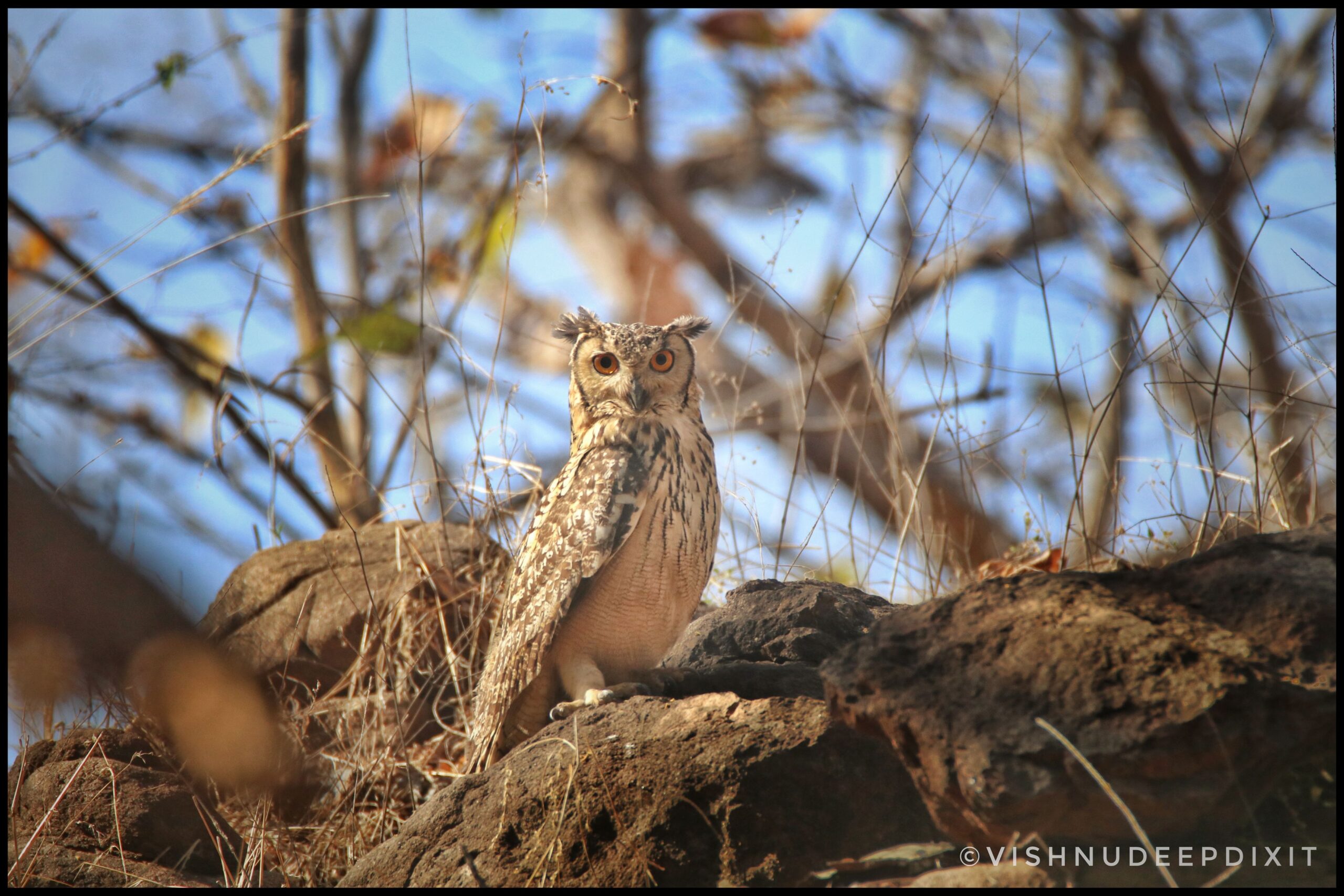“A wise old owl sat on an oak,
The more he saw the less he spoke.
The less he spoke, the more he heard.
Why can’t we all be like the wise old bird?“
Thus, someone spoke ever so aptly, in an ancient nursery rhyme that many of us grew up to. This very unique, mellow and wise species has managed to capture the imagination of many over the centuries.
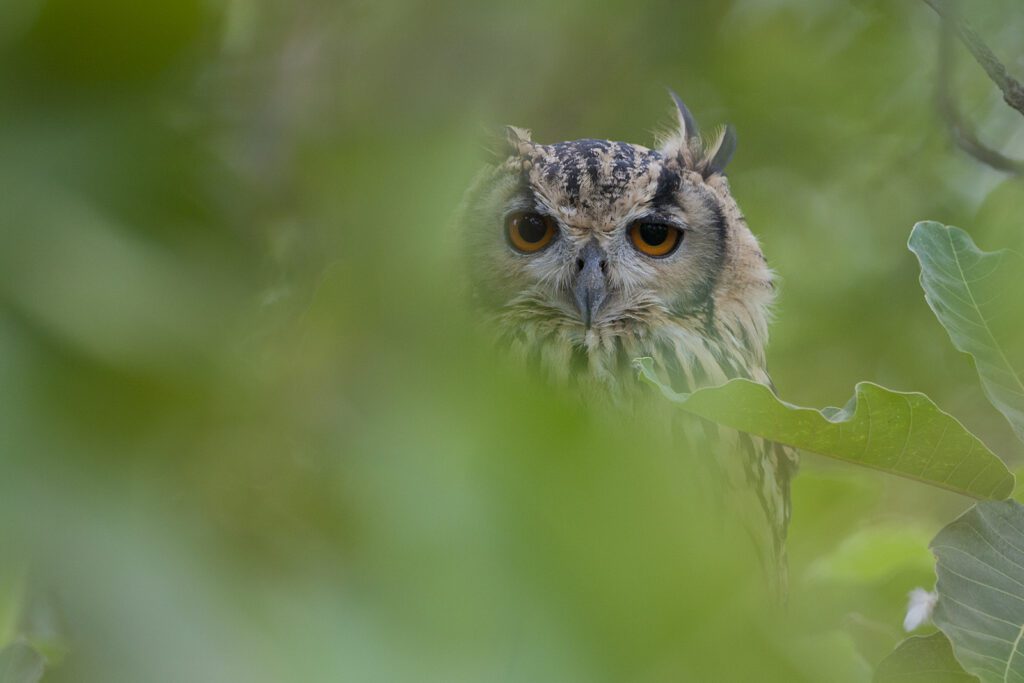
About Owls
Steeped in lore and wisdom, owls are one of the most fascinating raptors or Birds of Prey, belonging to the order Strigiformes. There are about 250 species of owls found worldwide, of which India is home to about 30-34 species. Mostly solitary, and mostly nocturnal with a few exceptions, these resident birds have a wide range of vocalisations.
Appearance: Owls are raptors that use sharp talons and curved bills to hunt, kill, and eat other living species. Quite different from other raptors like hawks, eagles, and vultures; owls have a broader head, forward-facing eyes, stocky bodies, soft feathers adapted for silent flight, short tails, and reversible toes that can point forward or backward.
Adaptations: They can rotate their head almost around 360 degrees which serves as a unique mechanism to capture their prey, and be aware of their surroundings. A binocular vision along with acute hearing abilities also plays a pivotal role in the hunting techniques, of this mostly nocturnal species.
Owls tend to regurgitate pellets containing indigestible bones, fur, and feathers, which serve as a good source for researchers to study their eating habits. Owls provide a pivotal ecological service by controlling agricultural pests, as they feed on rodents, shrews, and small insects and are at the apex of trophic levels in terrestrial and aquatic. ecosystems.
Distribution: Owls are found in a wide variety of habitats, from thick forests, meadows, and farmlands to even residential areas, where they can find rodents in abundance. They are found across all continents, except Antarctica.
Vocalisations: Owls have a varied variety of calls ranging from hoots to whistles, screeches, snorts, chitters, etc. Hooting is associated with courtship and is essentially a territorial call. Males have a lower-pitched hoot than females. And not all species hoot like we just shared. Some owls make clicking noises, when under threat.
Mobbing: Even though Owls are predators, they are feared by many birds. Therefore, they are often attacked or harassed by groups of smaller birds, like Drongos, Babblers, Crows, etc. This is not limited to one species, as once the attack begins, many different birds tend to join in. Interestingly, the Owl rarely responds to harassment, and it is just as rare for the Owl to be injured in any way, except in some odd exceptional cases of juveniles. The mobbing may force the Owl to move on to a different area. The retreating Owl is often pursued by the mob. (partly from Deane Lewis, 1999)
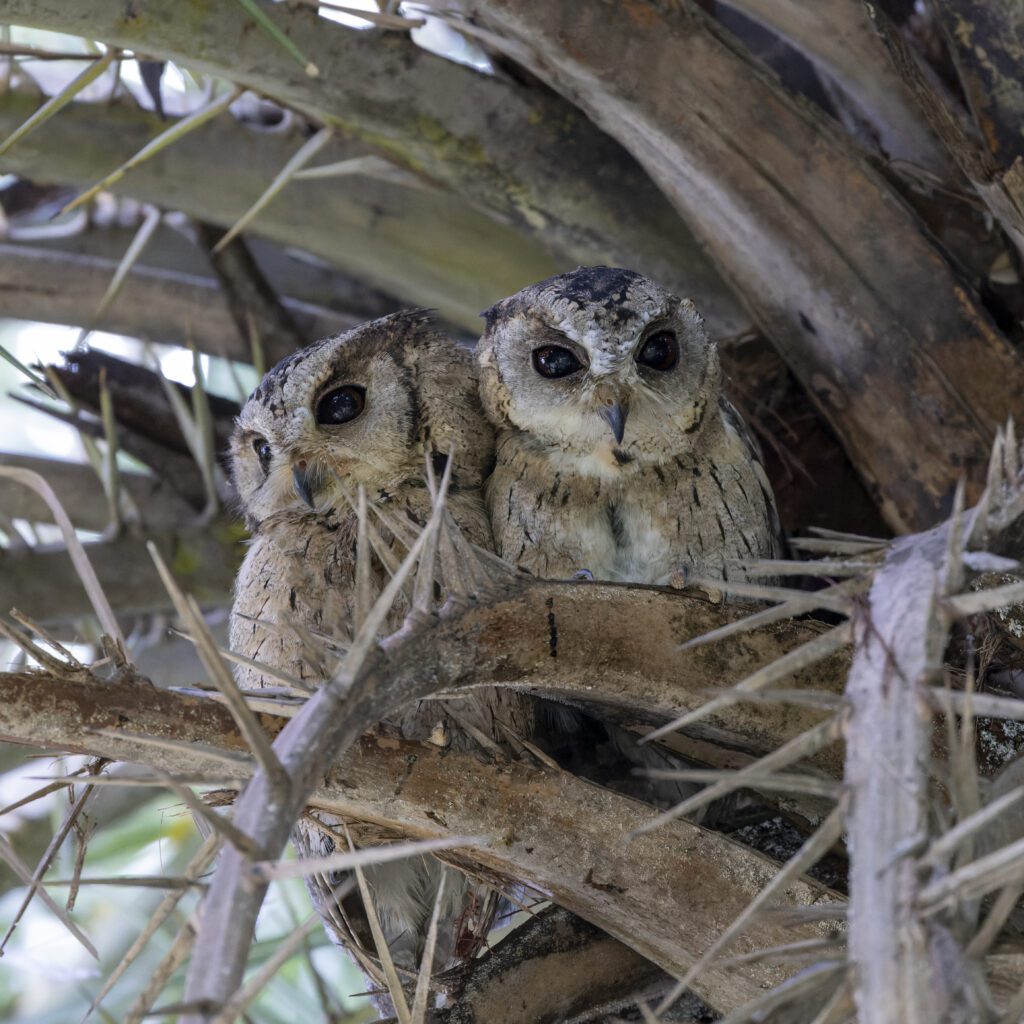
Mating and Nesting: Owls usually mate in late winter. Males tend to call out and seek the females. In a few species, upon gaining interest in a female, the male engages in showing off by fluffing its feather, or performing a courtship dance a few times, before he can finally impress her, or not. If the female follows him, they become a mating pair.
A male Short-eared Owl circles high above the female he courts, while clapping his wings under his belly, several times during a dive. It then flies up again and hangs in the wind. He sometimes repeats this impressive dance several times, to woe the female.
Not particularly efficient nest builders, owls usually appropriate an abandoned crow or hawk nest, or use a natural tree cavity or hollow, or abandoned bird hole. Owls are fairly vocal during nesting season, enhancing courtship and territorial calls, helping the mating pair bond and raise the fledglings, while dissuading other intruding owls. The male owl finds the nest, but the female decides on the final nest. As a pair, they defend the nest and the nest area serves as a family home for a few months. Barn Owls typically nest in the rafters of barns, in buildings, towers, or silos, or in cavities along cliffs, or abandoned hawk nests
Roosting: At the end of a day or night spent hunting, owls return to a resting place, called a roost. Most owls roost alone, or near a nest during the breeding season. However, there are a few species that roost communally, or share a roosting area with other individuals of the same species. The roost tends to be close to a hunting ground where they can find their prey easily.
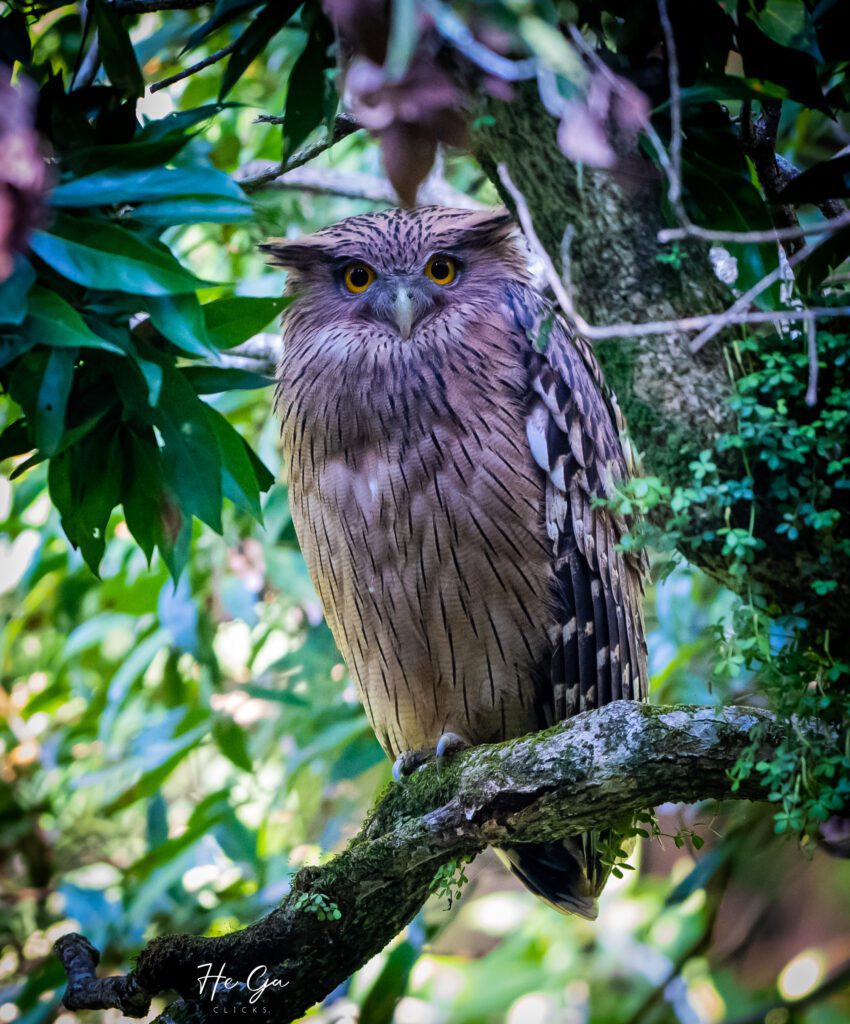
Owls in India and Central India
Owls belong to a group of birds called Strigiformes. That group is divided into two smaller groups, known as families. The family called Tytonidae includes Barn Owls, which have heart-shaped faces. The second family, Strigidae, includes all other owls, most of which have round faces.
India is home to about 30-34 species of Owls belonging to the families Tytonidae and Strigiformes.
Central India with its thriving landscape serves as an ideal habitat to various species of owls, that play a relevant role in balancing our ecosystem. Here are some of the owl species that can be readily found in the Central Indian forests.
When you take a trip to our lodges at Pugdundee Safaris, make sure you keep your eyes and ears open for these elusive, and fascinating species.
Common Barn owl (Tyto alba)
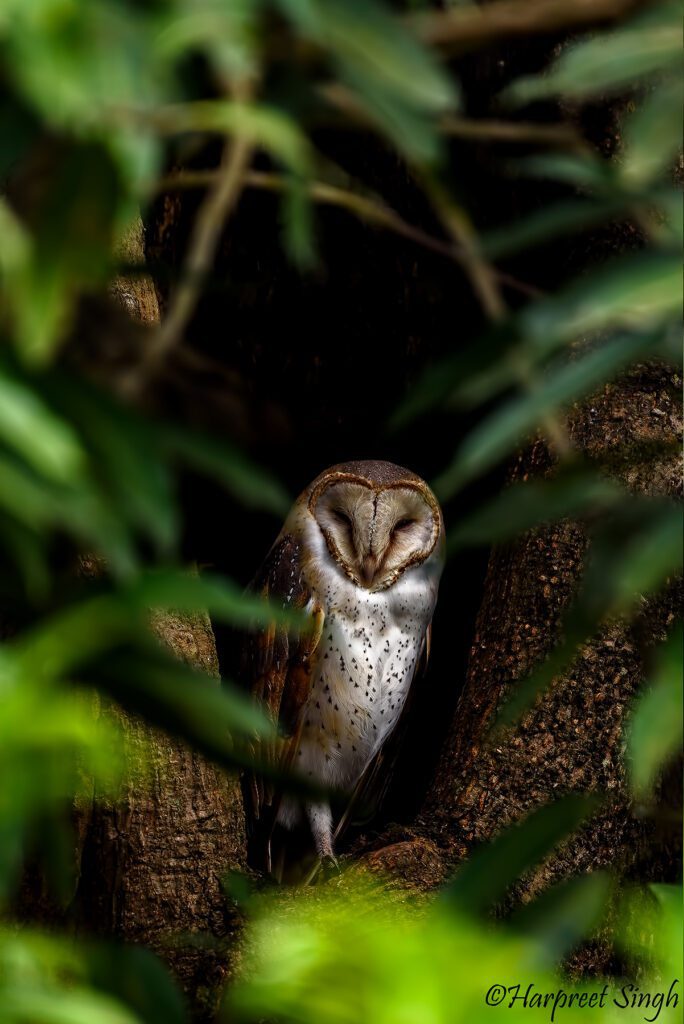
The Barn owl is the most widely distributed species of owl, found almost everywhere in the world except for the polar and desert regions like Antarctica, and Pacific Islands like Micronesia and in the North Of Himalayas. Also known as Common Barn Owl, they belong to the Tytonidae family
Description: Referred to as the “monkey faced owl” by some people, due to it’s facial features, a Barn Owl is medium sized, with a heart-shaped face and no ear-tufts. Distributed worldwide, these pale coloured owls have been named Barn Owls owing to their traditional use of barn lofts and church steeples as nesting sites.
The scientific name Tyto means “night owl, and alba refers to its “white” colour. It is not surprising that the scientific name had come from its physical morphology. The facial disc of a Barn Owl is white with a brownish edge. Females have darker bodies with more spots compared to males, hence it’s easy to differentiate a male from a female.
Size: they are about 29-44 cms in length and weigh approximately 250-500 gms. Females are often heavier than males.
Habits: Barns owls are very elusive nocturnal hunters, although it is not uncommon to see them emerge at dusk or active at dawn, and very occasionally on flight during daylight.
Calls and Hunting: Even though Barn owls have excellent vision at dawn, they depend on their skill of hearing to hunt. Unlike other owls, Barn owls do not hoot, but they vocalise by screeching very loudly and using raspy calls.The courtship call is a shrill repetitive twittering.
They specialise in hunting small ground mammals, and majority of their food consists of rodents like filed mice, shrews, rats. Their other prey includes bats, frogs, lizards, birds, insects etc. Even though barn owls have excellent vision at dawn, they depend on their acute sense of hearing to hunt. It is common to find them where rodents abound, and they prove to be valuable in controlling the pest population, thus proving to be a farmers best friend.
They have a noiseless flight, thus catching their prey without any warnings.
Habitat: They inhabit places like open woodlands, sometimes deciduous forests, agricultural fields, barns, abandoned houses, even city high-risers (due to availability of rodents), thus helping control the rodent population.
They usually roost in the day by tree hollows, and are also seen roosting in wells, caves, roofs, out buildings, parapets of buildings, or thick foliage.
Nesting and Breeding: Barn Owls don’t make nests, instead use nesting sites used by generations of owls. The nest is covered with feather and faecal matter, and that helps keep the eggs warm. They usually nest on heights to keep the eggs and juveniles safe like caves, buildings, barns, or other man made structures. They usually breed any time of the year, and once or twice a year, depending on the climate.
They lay up to 4-6 clutches of eggs and the young adults leave the nest in about 50 days. They then are ready to breed in about 10 months. They usually mate for life.
Life Span: Barn owls can live up to 2-4 years in the wild, although the oldest recorded life span of a barn owl was around 14 – 24 years in captivity.
IUCN Status: Least Concerned
Best seen: Although these are widespread across Central India, they can be easily sighted at Van vihar, Tadoba -Andhari National Park, Pench National Park
Oriental Scops owl (Otus sunia)
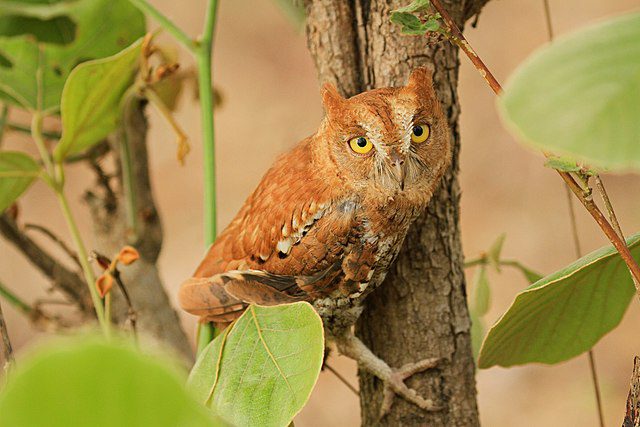
Skopos (Greek) – Watcher, Gaurdian
Oriental Scops owls are mostly found in Eastern and Southern Asia.
Description: The Oriental Scops owl has a small head with tufts/ears. The facial disc is white or buff. This is a small and agile nocturnal owl, and they have different morphs (polymorphs), ranging from greyish brown, brown, and rufous and a very rare morph is the golden morph.
Size: They are about 17-21 cms long and weigh about 75-95 gms only. The females are a bit heavier than the males.
Calls and Hunting: Because of their smaller size, Oriental scops owl depends majorly on insects for their diet. They feed on grasshoppers, locusts, small rodents, and small reptiles such as lizards, and agamas. They are perch-hunters.
Their call is a 3 to 4 note series of hollow-sounding notes, with the last two in rapid succession.
Habitat: These owls inhabit woodlands, orchards, gardens, parks, dense forests, dry deciduous, mixed forests or evergreen forests, agricultural fields, plantations, groves and often close to human habitation.
Nesting and Breeding: The breeding season ranges in different areas, but it is believed to range from February to June depending on the area. They usually nest in a tree cavity, hole in a wall. Clutch size is about 3-4 eggs that incubate in about 25 days. The female incubates these alone, while the male provides the food.
IUCN Status: Least Concerned
Best Seen: Best places to look for these owls in Central India is Kanha National Park and Panchmarhi Wildlife Sanctuary.
Brown Fish owl (Ketupa zylonensis or Bubo zylonensis)
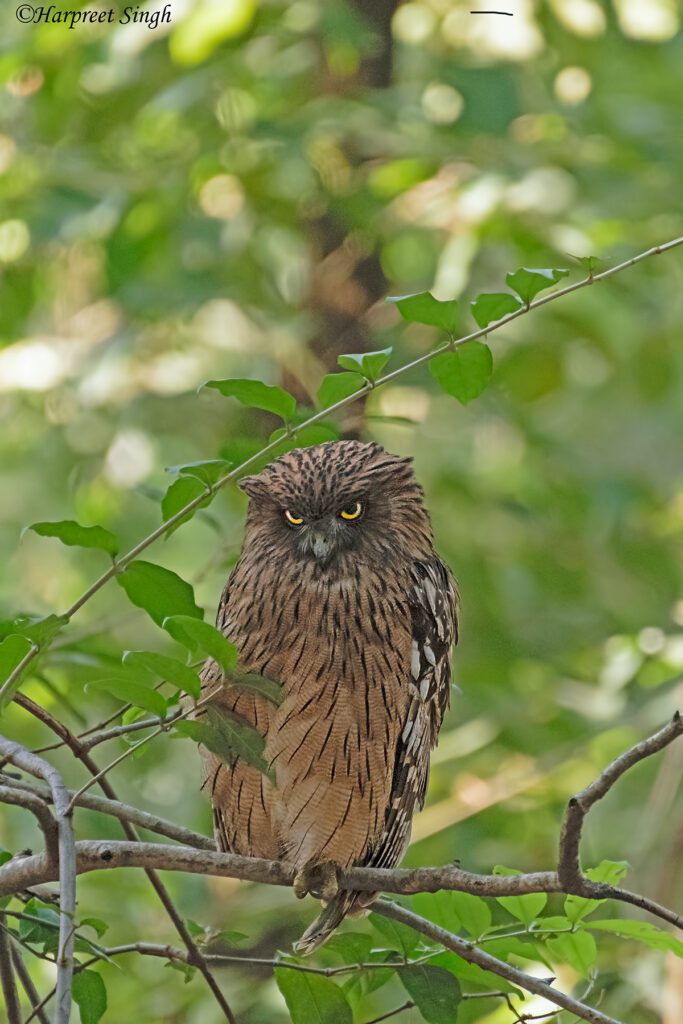
The Brown Fish owl is a large bird and is found in Malaysia, Sri Lanka, Bhutan, Nepal, Bangladesh, Myanmar, China, Hongkong, Thailand, Cambodia, Iran, India, Pakistan and Laos. It belongs to the Strigidae family inhabiting warm tropical or sup-tropical parts of Asia and some off shore islands.
Description: There are also 4 subspecies Brown fish owl. The distinct facial disc of this owl is tawny, with black shaft-streaks on individual feathers. The ear tufts are bushy and tousled and the eyes are golden-yellow.
Size: They are about 48-58 cms long, and weigh about 1-1.3 kgs, much heavier than the other owl species.
Habits: They are semi-diurnal, roosting in large trees during and day and flying away by dusk. They are seen hunting on cloudy days and in daylight sometimes. They bathe by wading into shallows and ruffling their feathers to dry and preening the plumage.
Calls and Hunting: These owls can be commonly seen perching along the water bodies as they hunt aquatic animals more than any other species. Their diet includes crabs, frogs, fishes, crustaceans, rodents, reptiles and other small birds. They hunt by watching from a perch for their prey, on a stump or rock; at the edge or middle of a stream. They sometimes skim the water. Fish are scooped up from the surface.
It is believed that due to the lack of an appropriate number of feathers, their flight makes sound unlike the other owls with silent flights.
Habitat: Brown fish owl mostly prefers woodlands and densely forested areas, or thick lowland forests, open-wooded country, but always near water. Also around human habitation, and lowlands of about 1800 m elevation.
Nesting and Breeding: The breeding period ranges from November to April. They nest in abandoned stick nests of large birds, or rock ledge near water or rocky banks, or ruins of old buildings. The clutch of eggs is often 1 or 2.
IUCN Status: Least Concern
Best seen: Tadoba Andhari Tiger Reserve, Kanha National Park.
Indian Eagle owl (Bubo benghalensis)
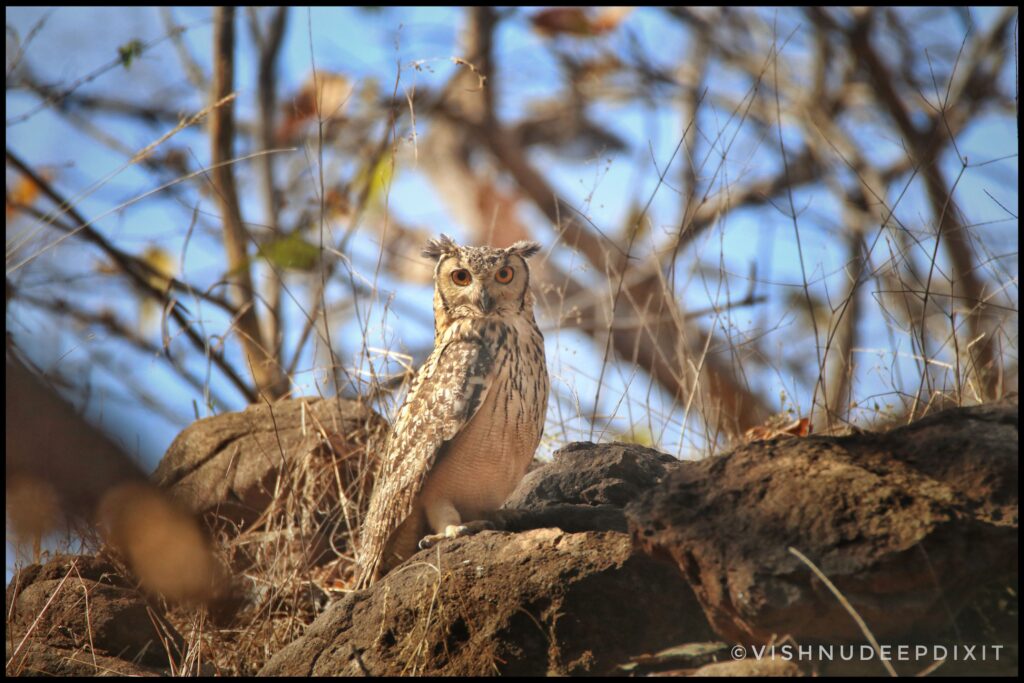
The Indian eagle owl is also called Rock Eagle Owl or Bengal Eagle Owl is a species of large Horned Owls that distributed along the Indian sub-continent to the south of the Himalayas. Usually seen in pairs, they are mostly found in scrub forests.
Description: The facial disc is fulvous-brown to buffy with a prominent blackish rim. The eyes are orange-yellow to orange-red and they have a greenish to slate black bill. The tufts of feathers on its head or horns is the reason why it belongs to horned owl species.
Size: They Indian Eagle Owl is about 50-56 cms in length, weighing almost 1100 gms, though the females are larger than males.
Habits: They are nocturnal, and fly slow, deliberate wing beats interspered with long moments of gliding, and they usually fly close to the ground. They can defend their young ones but diversionary tactics like feigning a wing injury.
Calls and Hunting: The male has a deep, resonant double hoot that goes like bu-wooh, repeated at short intervals. Though the female sounds similar, but she has a higher pitch. Although they eat rodents, their diet majorly consists of birds, and they are seen hunting big birds as well; such as peafowls, kites, and others like spotted owlets, Indian rollers, doves etc. They also prey on reptiles, crabs and large insects. They hunt from a perch, but do make low foraging flights to dive onto the prey.
It is also known to tear up prey such as rodents, instead of swallowing it wholly unlike other owls.
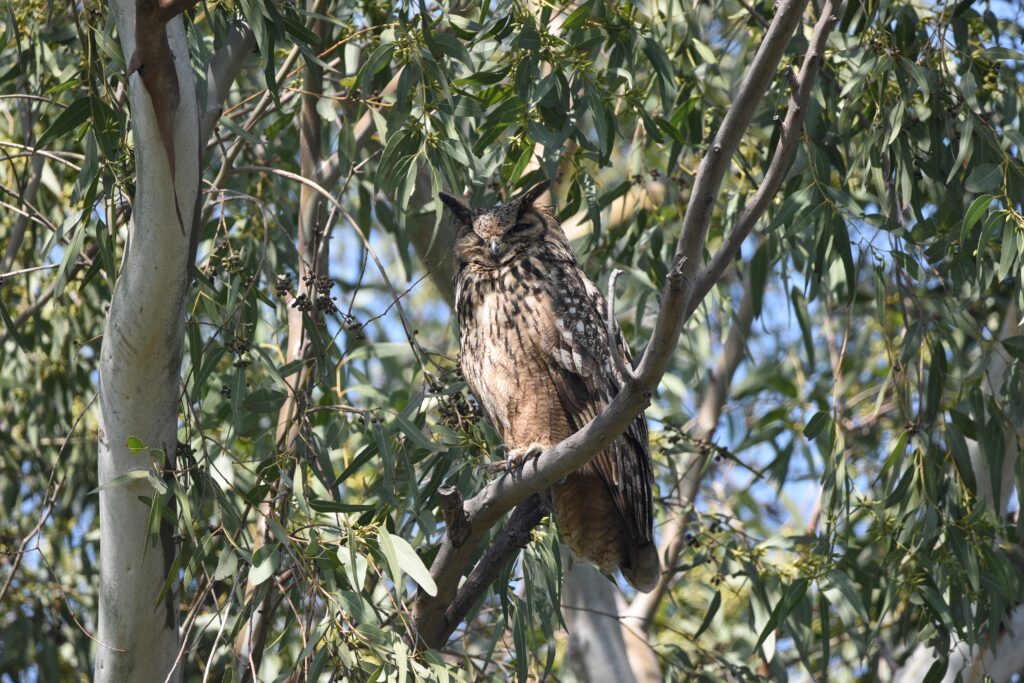
Habitat: These owls do not depend on the dense forests, they often prefer shrub lands, medium-dense forests and rocky hills or rocky patches. They also live alongside steep bank covers and hilly areas with water streams as they hunt the best in these areas. They have also been seen to inhabit mango orchards, close to human habitation.
Nesting and Breeding: They usually breed from February to April, but this varies and can also be October to May. The nest is a shallow scrape on bare earth, protected by rock ledge, river banks, or a ravine or cliff recess. Often the clutch of eggs is 2-4. The mother incubates the eggs for around 35 days, after which the chicks depend on the mother for the next 6 months as they grow up.
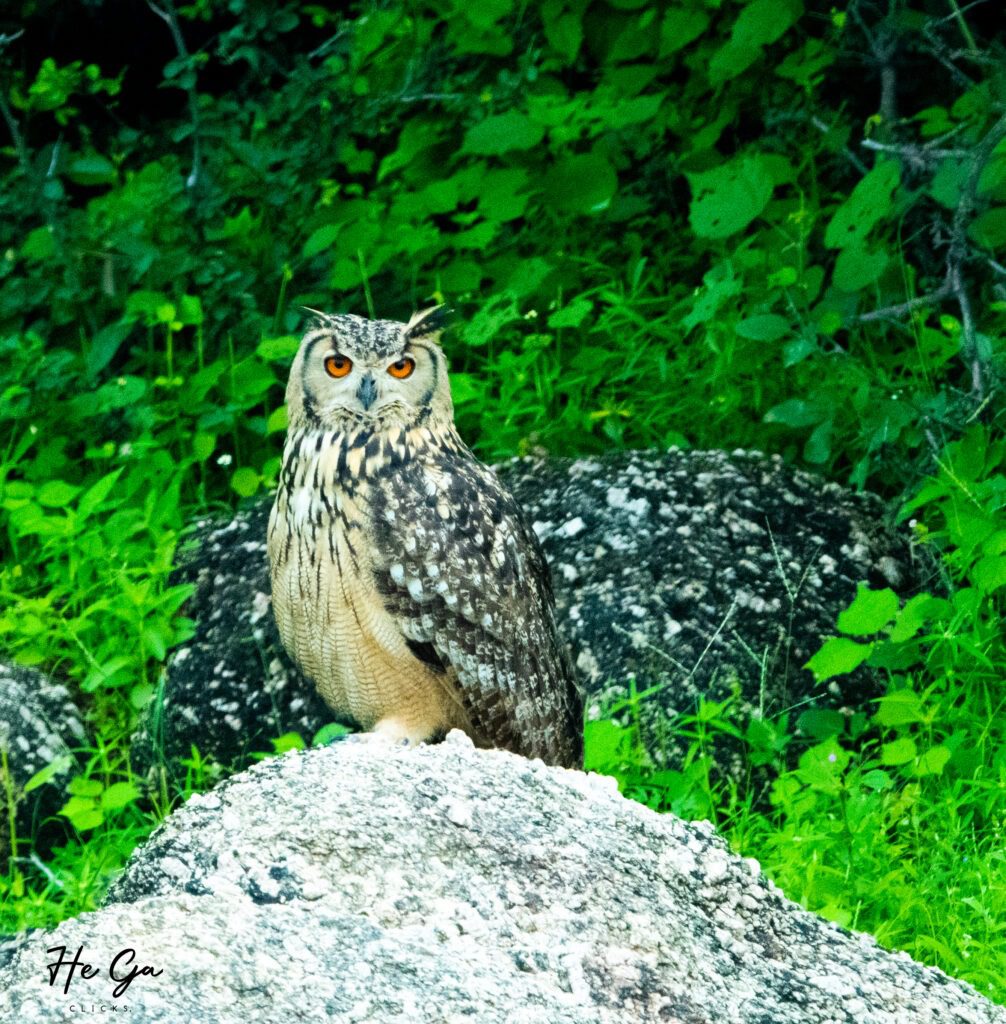
IUCN Status: Least Concern
Best seen: At forests with rivers such as Satpura, Narmada River passing through Jabalpur, Ken River at Panna.
Brown Hawk owl (Ninox scutulata)
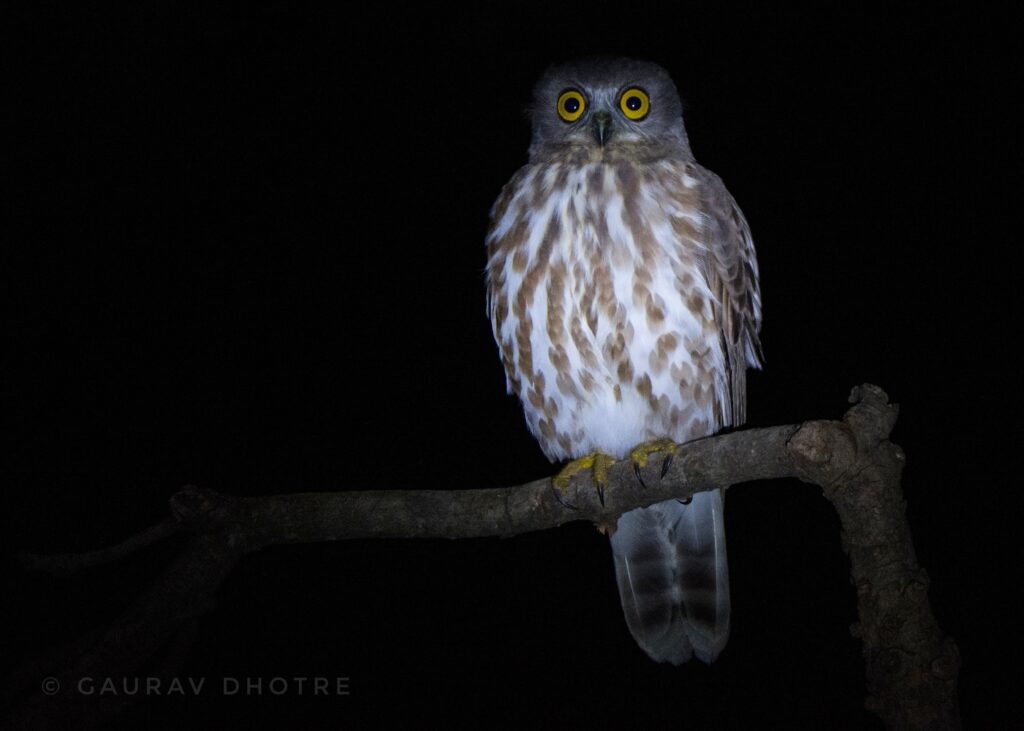
The brown hawk owl is also known as Brown Boobook; is a resident breeder is distributed in the Indian sub-continent and other parts of Asia such as Myanmar, Vietnam, Sri Lanka, China, Malaysia, and Bhutan. It belongs to the larger group of owls, Strigidae containing most owl species.
Description: The facial disc is brown with plenty of narrow, whitish, radially orientated streaks. The eyes are a bright yellow with a narrow dark circumference. The bill is bluish-black with a paler tip. It has a white spot on the forehead and most of the back, mantel and wings are uniform chocolate-brown.
Size: They are about 27-33 cms long and weigh about 170-230 gms. Males of this species is larger than females.
Habits: They are crepuscular and nocturnal raptors. They roost during the day solitarily or in pairs, on shady branches that are thickly covered with leaves or creepers.
Calls and Hunting: They have a pleasant, musical call that is not loud, yet carries far. They sound like whoowup whoowup, or woop notes. These are uttered in series with very short pauses of micro-seconds. They may also have another vocalization that is shrill, nasal heeoo or a quiet, rolling kerrrr like a purring cat or a meew like a mewing cat.
Brown hawk owl hunt for insects, beetles, grasshoppers, and other species like birds, lizards, frogs, small bats or crabs too. They hunt at dusk using a perch for a tree-stump, or a post looking out for their prey.
Habitat: They are found in is thickly wooded forests, with good canopies, broad leaved trees, around water bodies and streams, grooves. They are also observed in urban areas which have tall trees, bushy trees. It is easy to identify this beautiful raptor with its big, unsettling yellow eyes. Often seen in pairs perching on a branch.
Nesting and Breeding: These species are monogamous and they mate for life. The breeding season is from March to June. The nests are built 5-20 meters above ground level in large or irregular holes or tree hollows. Sometimes even on the ground on wooden piles.
The same pair uses the nest hollow for successive years. The egg clutch contains about 3 to 5 eggs on average. The female incubates the eggs, while the male forges for food for them. The fledglings leave the nest in about 27 days or so and are fed by both the parents.
IUCN Status: Least Concern
Best seen: Satpura National Park, Melghat Tiger Reserve have the best sightings of this species.
Indian Scops Owl/Collared Scops owl (Otus lettia)
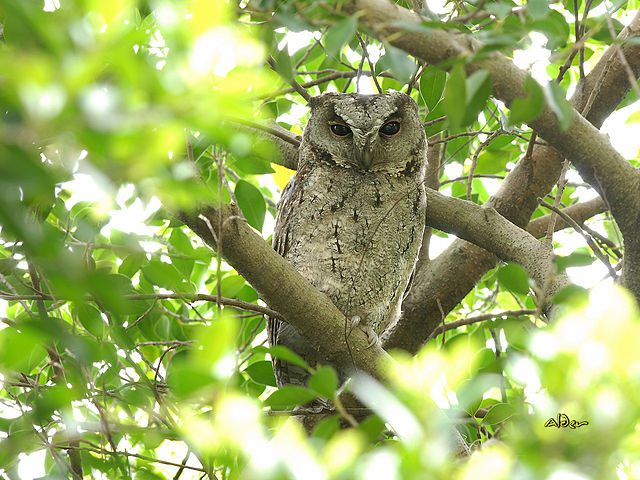
Indian Scops owl is a small owl with rather long, dark-spotted ear-tufts. Earlier known as the Collared Scops owl, they are often seen in woodland habitats and rural set-ups.
A resident breeder across South Asia Asia, including Northern Pakistan, Northern India, Bhutan, China, Bhutan, Vietnam, Malaysia, Myanmar, Thailand, Cambodia, Taiwan; this owl is partially migratory, with some wintering in India, Sri Lanka and Malaysia. Larger and more strongly tufted than both Oriental and Mountain Scops Owls. Both these species also lack the black facial border, which the Collared Scops Owl has. Seen in grey-brown and a rufous morph
Description: Indian Scops owl have very prominent ear tufts which are also known as horns. The facial disc is dull yellow with faint and darker concentric markings. Eyes of the Collared Scops Owls are dark brown to orange brown. They bill is a light green horn, paler at the tip.
Size: It is a small owl about 23-25 cms in length, wieghing approximately 100-170 gms only. Females are larger and heavier than males.
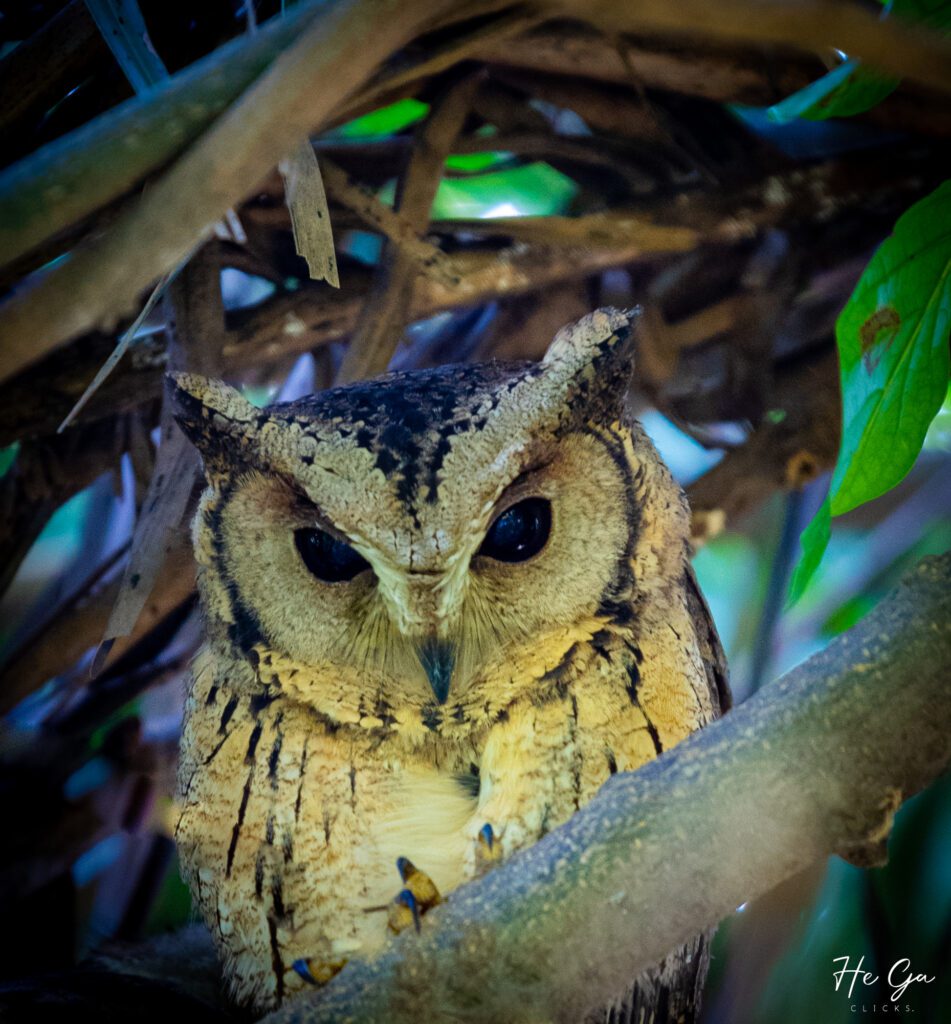
Habits: They are completely nocturnal and rarely seen during the day. They are seen roosting in tree holes or sitting very still, upright and motionless on densely foliaged branches and camouflaging themselves with the bark. Hence, ones needs a very keen eye to spot them in the bushes and woodlands.
Calls and Hunting: Indian Scops Owl have a single, mellow hoot –“buuo” repeated in short intervals. Though it’s vocalisation, just like it’s plumage may vary across its large range. Their diet includes insects like beetles, grasshoppers, mantises and other big insects too. But they also prey on small reptiles, like lizards, amphibians and mice, as well as some small birds. They have been seen hunting night jars as well.
Habitat: Open country, meadows and towns, forests, scrublands, grooves of trees and bamboo habitats. Their range is from plains to sub-mountainous tracts, to about an elevation of 2400 m.
Nesting and Breeding: They breed from about February to May. They lay around 3-5 clutches of eggs and nesting is often in a tree cavities, or woodpecker holes, in trunks or dead stumps, mostly at a height of about 2-5 m, but sometimes more.
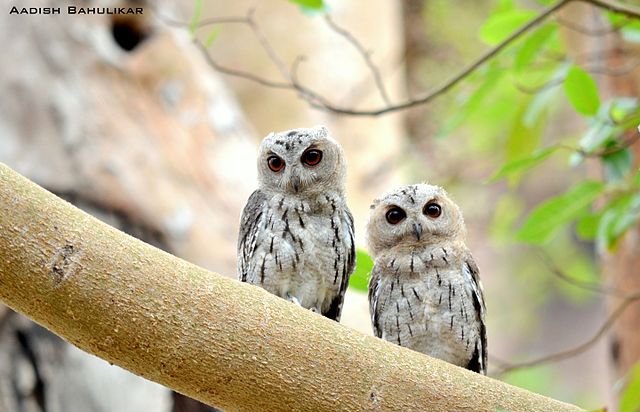
IUCN Status: Least Concern
Best Seen: Pench National Park and Kanha National Park.
Short-Eared owl (Asio flammeus)
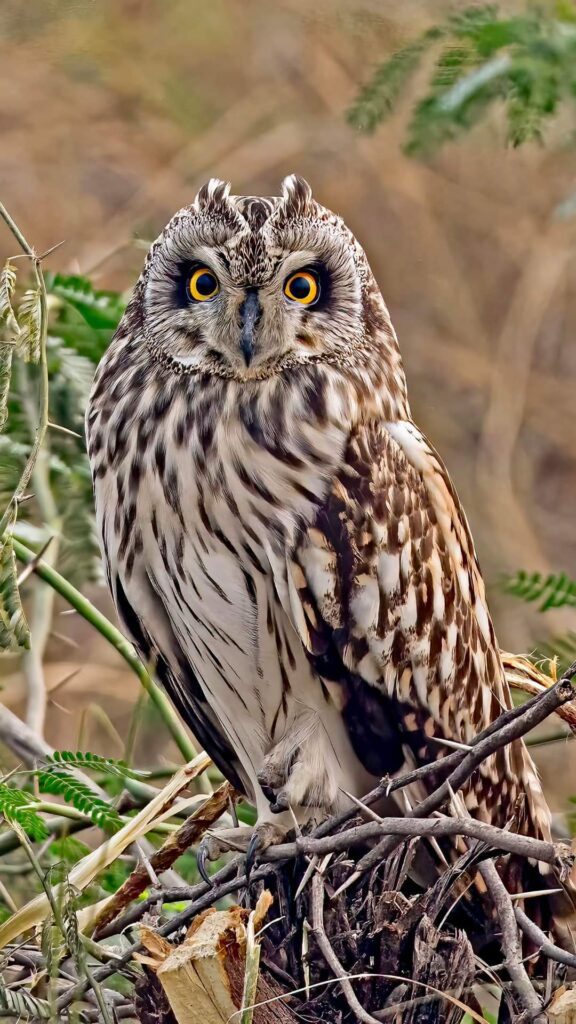
The Short-Eared Owl belongs to the family Strigidae. Owls belonging to the genus Asio are known as eared owl as they have tufts of feathers resembling mammalian ears. The ear tufts of this owl are so small that they are invisible. Asio flammeus displays its tufts when in a defensive pose. Flammeus is a Latin word that stands for “flaming or the colour of fire”.
They occur widely in Iceland, Hawaiian islands, North and South America, Rann Of Kutch in India is its favoured winter habitat, and in Madhya Pradesh, India too, in grasslands and open countryside. The Northern populations are migratory and nomadic. They are winter visitors to Central India.
Description: The facial disc is pale ochre with a blackish rim. Eyes are yellow to bright yellow. The bill is a blackish horn and claws are greyish with darker tips. The ear tufts are set together, almost near the centre of the forehead. Crown and nape are distinctly dark streaked, yellowish and tawny. The feathers are barred in shades of light and dark.
Size: 33-43 cms, weighing 210-430 gms. Females being larger than males.
Habits: Short-eared owls are generally nocturnal, but also show diurnal features. They are seen to become active close to sunset. Some are also seen to be active during the day, when it is breeding season. Flight is deep, slow, moth-like rowing wing beats, and seen to glide on stretched wings over open landscapes.
Calls and Hunting: They are quiet, due to partial diurnal nature, but a male’s territorial song is a pulsating “voo-hoo-hoo” resembling an old steam engine; to which the female responds with a barking “kee-ow”. The male calls out the territorial song on flight display. They also have different calls when disturbed or excited near their nests that may be a squawk, bark, hiss or squeal.
Short-eared owls hunt at night mainly, but also early mornings and late afternoons. They mostly depend on rodents for their diet, but they also feed on shrews, mice, hares, bats, chicks of other birds, and small birds. Instead of gulping the birds directly like most owls, they remove all the feathers of the birds before eating them.
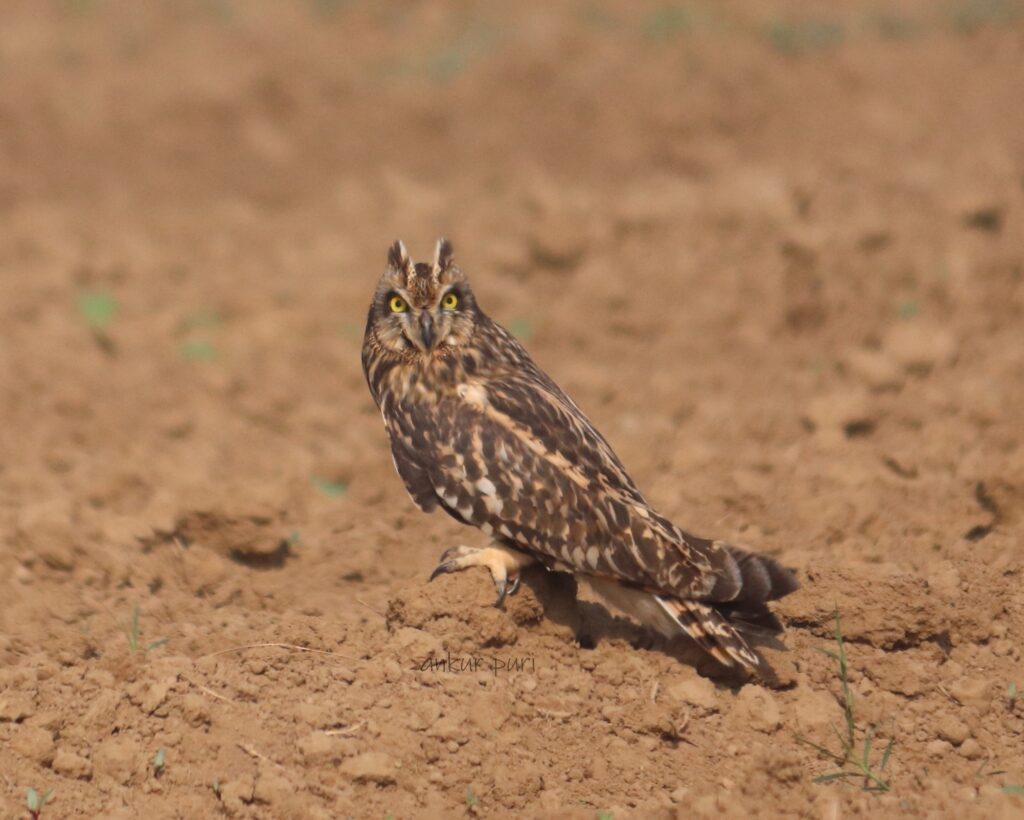
Habitat: These owls prefer wide open spaces such as open grasslands, agricultural lands, meadows, dumps, rocky gravels, salt marshes, estuaries, mountain meadows and alpine and Arctic tundra.
Nesting and Breeding: The males perform courtship dances which include aerial displays that are acrobatics in the air.
Short-eared owls build their own nests, unlike many other owls. The clutch includes about 1 to 11 eggs. The Short-eared Owl also nests on the ground, unlike most other Owls. Nests are usually situated in the shelter of a grass mound, under a grass tuft, or among herbaceous ground cover. Nests are loosely constructed by the female, who scrapes a spot on the ground, and then lines the scrape with grass stems, herb stalks, and feathers plucked from her breast.
The female incubates the eggs, while the male provides food, occasionally taking turns to incubate. They may raise two broods in a year. The young grow rapidly after hatching, and begin to wander from the nest within 12 days, an adaptation for a ground-nesting species; to reduce the amount of time they are vulnerable to predation. Young fledge at about 4 weeks.
Unlike mostly solitary nature of other owls, the Short-eared owl favours communal roosting; if the habitat is favourable. No wonder, that’s how we witness a “parliament of owls’ the perfect collective noun to describe them.
IUCN Status: Least Concern
Best Seen: Very rarely sighted but sightings in the patches of Madhya Pradesh’s forests.
Spot-Bellied Eagle Owl/ Forest Eagle Owl (Bubo nipalensis)
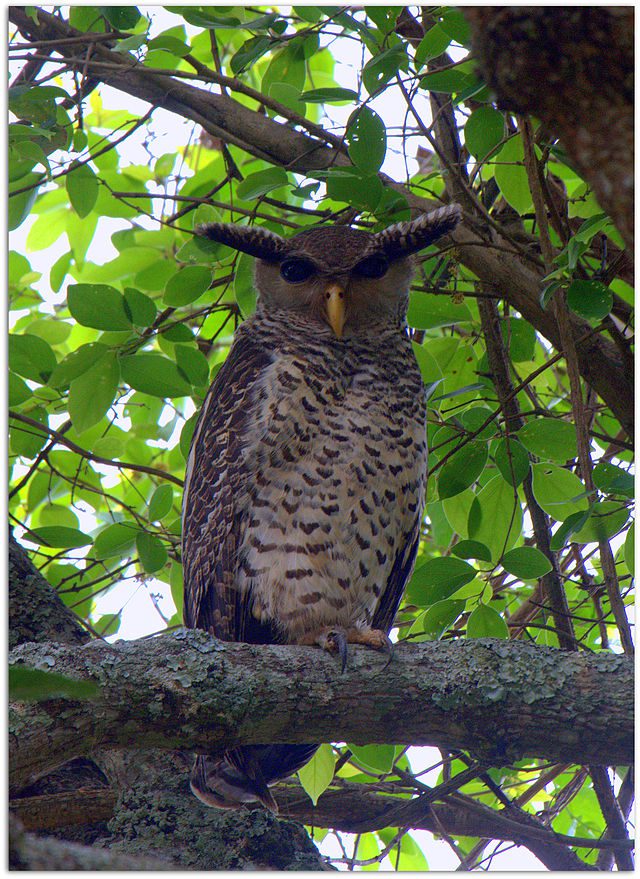
The Spot-bellied Eagle owl is also known as Forest Eagle owl, and is one of the large species of owls. These are found throughout the Indian Sub-continent, the lower Himalayas, and South-East Asia like Sri Lanka, and Thailand.
Description: The facial disc is pale minus a dark rim around it. The eyebrows are whitish and the eyes are dark brown with pale-grey eyelids. The bill is wax-yellow or pale yellow. Ear tufts are dark brown with inner web barred with fulvous white. The adult is silverish grey with a yellow beak
Size: With a length of about 51-63 cms, these owls weigh approximately 1300-1500 gms.
Habits: The Forest Eagle owl is mostly nocturnal and roosts, during the day on densely foliaged branches in the forest.
Calls and Hunting: They have a low, deep double hoot – “hoo, hoo” lasting fraction of seconds. The Forest Eagle owl also utters a mournful, mewing scream that rises and then falls in pitch and lasts about one second – “njaauuuw“.
They are mostly forest-dwelling birds and are at top of the chart as the avian predator in their range. They hunt by pouncing on roosting birds at night time. They have been seen to hunt small mammals, rodents, and other birds like peafowls, jungle fowls, pheasants. Other preys include lizards, snakes and fish. This predator has been seen to hunt hares and young ones of jackals, and barking deers.
Nesting and Breeding: Spot Bellied owls nest during the period of December to March, and sometimes it has also been seen that they breed until late June. The nest is a big hollow in an old tree, and sometimes they also use abandoned stick nests of other birds of prey, and sometimes the bare soil in a cave or horizontal fissure amongst rocks. The clutch of this species includes just 1 egg.
Habitat: Dense evergreen and moist deciduous forest, dense riparian forest, alluvial hilly country interspersed with tracts of dense forest and Himalayan foothills in the north. Also in montane evergreen wet temperate forest in the southern hills in India and Himalayas. Tropical rainforest in Burma, Thailand, Laos and Vietnam. Ranges from lowlands and foothills to about 1500m. In the Himalayas, mostly ranges from about 900-2100m, but sometimes up to 3000m elevation. May be found up to about 1800m elevation in Sri Lanka.
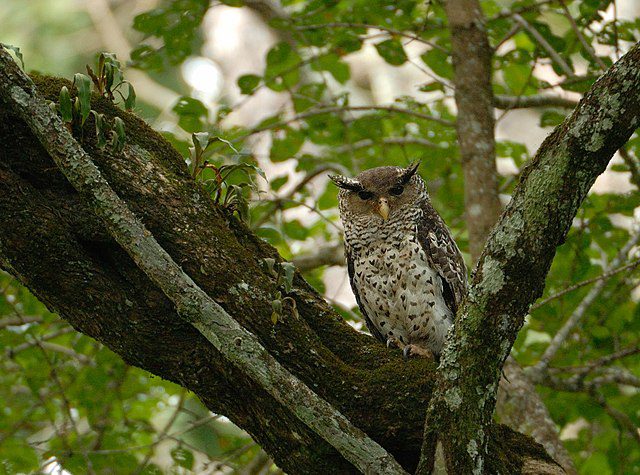
IUCN Status: Least Concern, yet they are threatened locally by poachers and used for black magic.
Best seen: There have been some records in Kanha National Park and Pench national Park.
Dusky Eagle owl (Bubo coromandus)
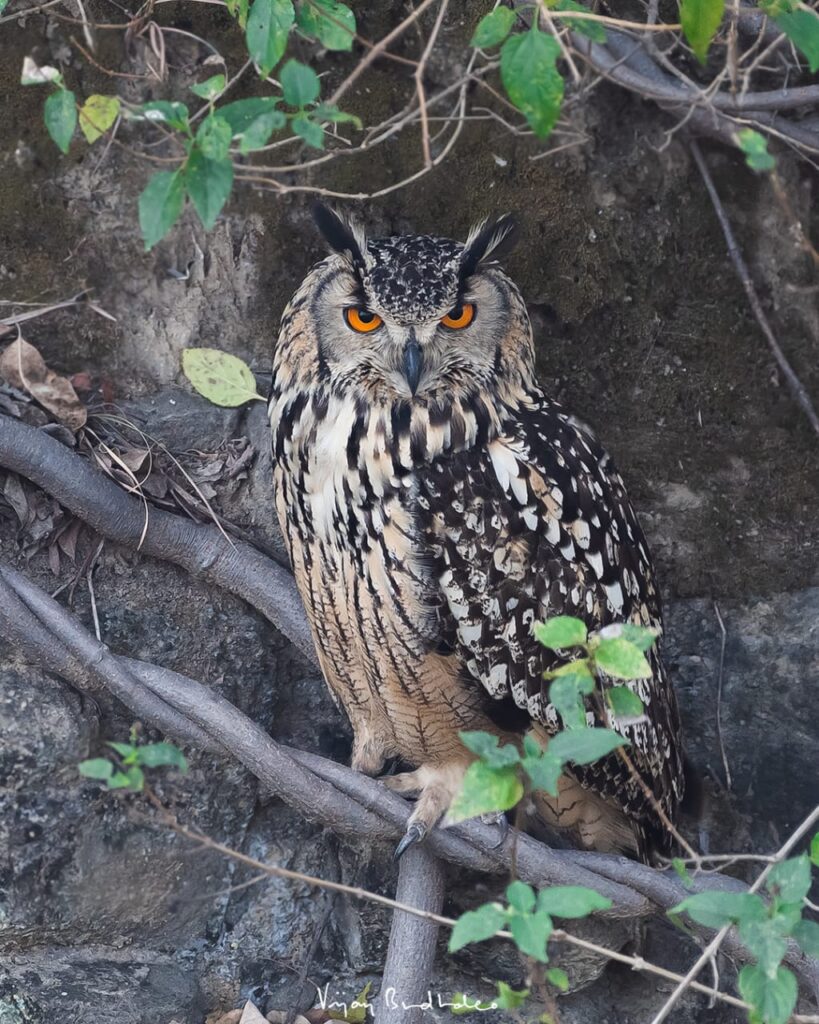
The Dusky Eagle owl has been recorded throughout the Indian sub-continent, Myanmar, Nepal, Bangladesh peninsular Malaysia, Thailand and parts of China.
Description: A very large, greyish owl with a facial disc that is whitish. The eyes are yellow and it has very distinctive ear tufts and have fine barring and dark streaks on the pale underparts, and white patches on the shoulders. In flight, wings and tail are strongly barred below.
Size: About 48-53 cms. The females are larger than males.
Habits: Perches in tall trees, usually near a water body, where it waits for birds and mammals to pounce upon. The Dusky Eagle Owl are not completely nocturnal and are diurnal, usually spending the daytime in the seclusion of a shady bough or foliage, becoming active about an hour before sunset. They are seen to move and hunt in the day, especially cloudy days, but never during the brightest and hottest hours.
Calls and Hunting: Found in pairs, they can be heard calling at all hours of the day, and are quite vocal during the rainy and cold seasons. The call is a distinctive series of low, guttural notes that increase in volume and speed before trailing off towards the end – “kro kro kro-kro-krokrokoikoikokog“, with the ending notes given in a rapid staccato sequence, resembling a tremolo. The pair duets during courtship.
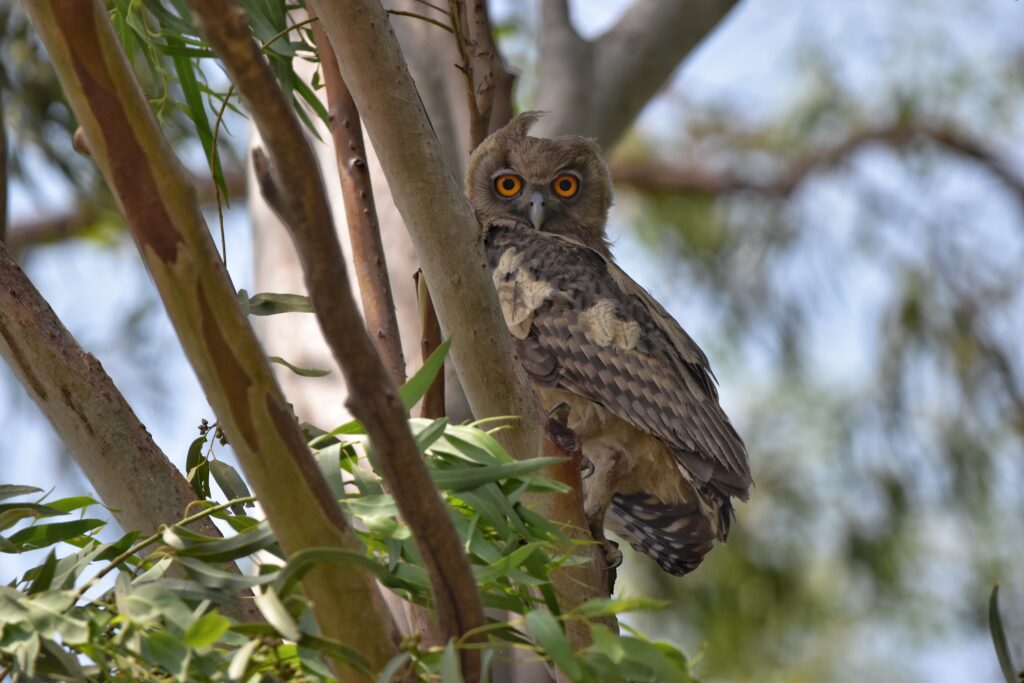
Habitat and Hunting: This agile raptor prefers wooded forests, agricultural fields, and big old trees on the avenue roads. Dusky Eagle Owls generally feed on small mammals, birds, reptiles, frogs, fishes, and large insects.
Nesting and Breeding: Breeding season spans from November to April. In Northern India, it is usually from December to January, and starts later in the south. The Dusky Eagle owl uses abandoned stick nests of larger birds in the fork of a large tree, preferably by water.
Normally two eggs are laid, sometimes only one. They are laid several days apart, so chicks tend to be different in size. Usually, only the larger and stronger one survives. While both the male and female incubate the eggs, most of the incubation is carried out by the female, and the male briefly covers for the eggs, when the female leaves the nest for a short time.
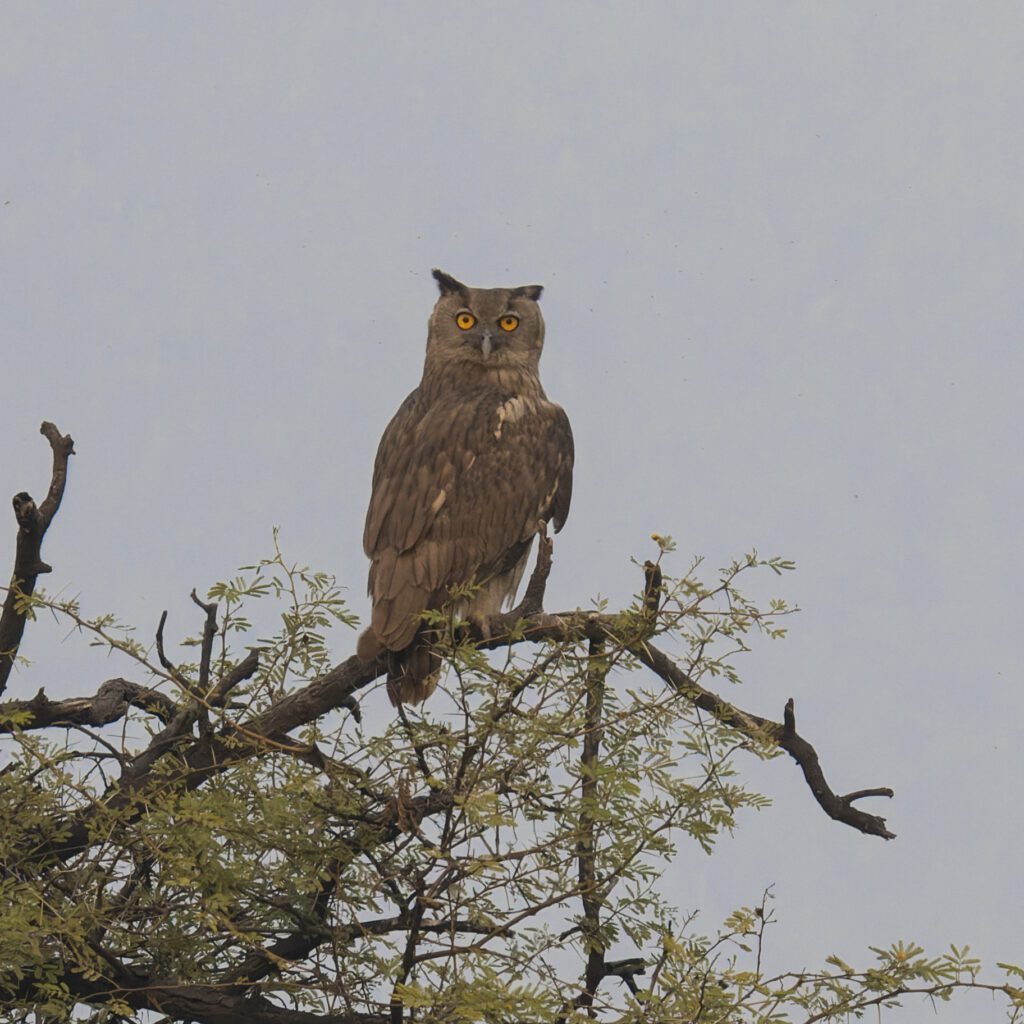
IUCN Status: Least Concern.
Best seen: Kanha National Park and Satpura National Park
Mottled Wood owl (Strix ocellata)
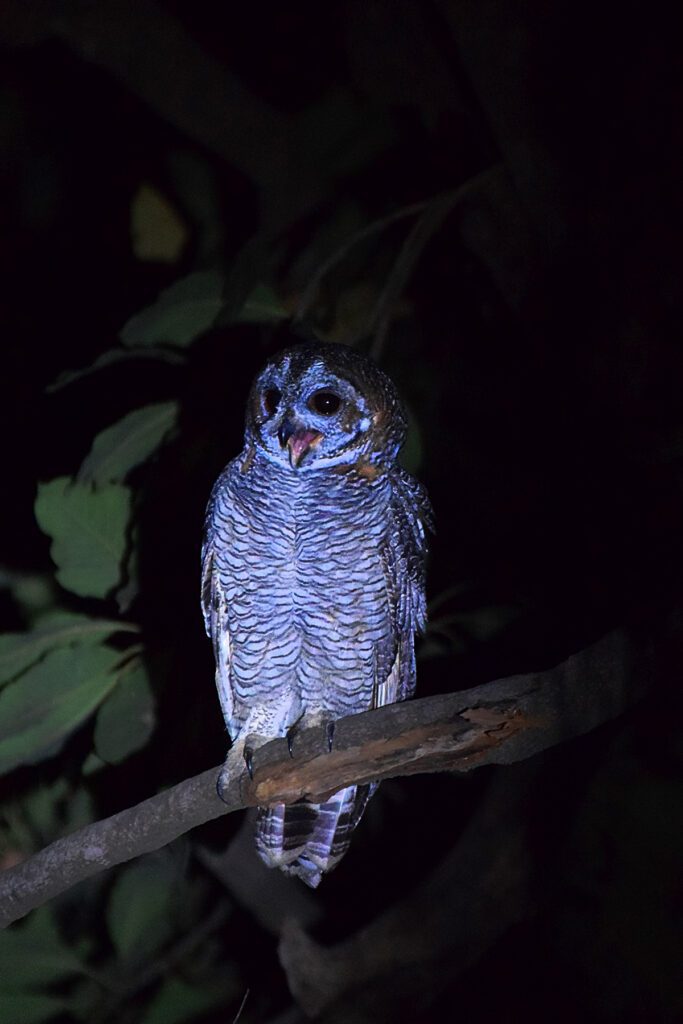
The Mottled Wood Owl is a medium-sized, yellowish-red owl with a round head. This owl doesn’t have any ear tufts, and it’s the morphology of the wings seems to be heavily patterned with the distinctive reddish and brown distribution. They are found throughout the Indian subcontinent.
Description: The Mottled Wood Owl has a facial disc that is whitish, and finely barred concentrically, blackish-brown. Eyes are dark brown and eyelids are dusky pink or dull coral-red. The bill is horn-black with a paler tip.
Size: Mottled Wood Owl measure 40-50 cms and weigh about 700-800 gms.
Habits: They mostly roost hidden in the foliage of trees in pairs, or alone, or in family roosts. They are nocturnal.
Calls and Hunting: During the breeding season, the male utters a loud, shivering, hollow, ‘laughing’ call – “Chuhuawaarrrr“, which is the territorial song. Both sexes also give a single, metallic hoots, as well as multiple conversational hoots. Sometimes they tend to vocalise through a harsh screech similar to a Barn Owls.
They prey on rats, mice, other rodents and squirrels; as well as birds up to the size of a domestic pigeon. They also feed on lizards, crabs, beetles and large insects.
Habitat: Their preferred habitat is wooded lands, plains, gardens, and dense forests.
Breeding and Nesting: The breeding period starts in November and it might extend till April, the clutch of the eggs is often seen to be two or three.
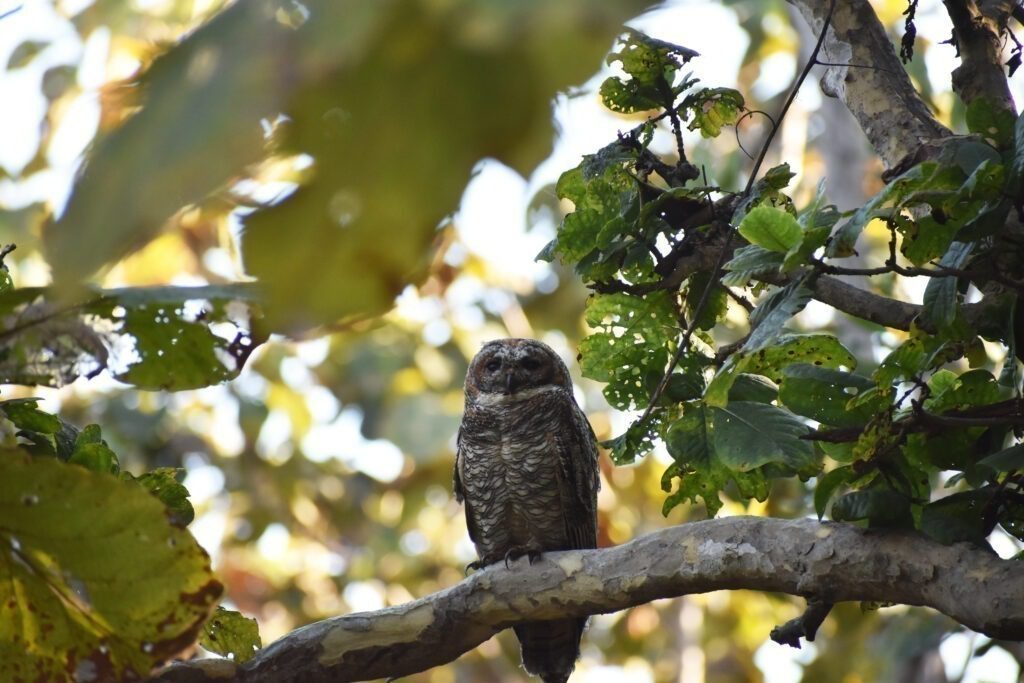
IUCN Status: Least Concern
Best Seen: Pench, Satpura, Tadoba, Bandhavgarh National Park
Jungle Owlet (Glaucidium radiatum)
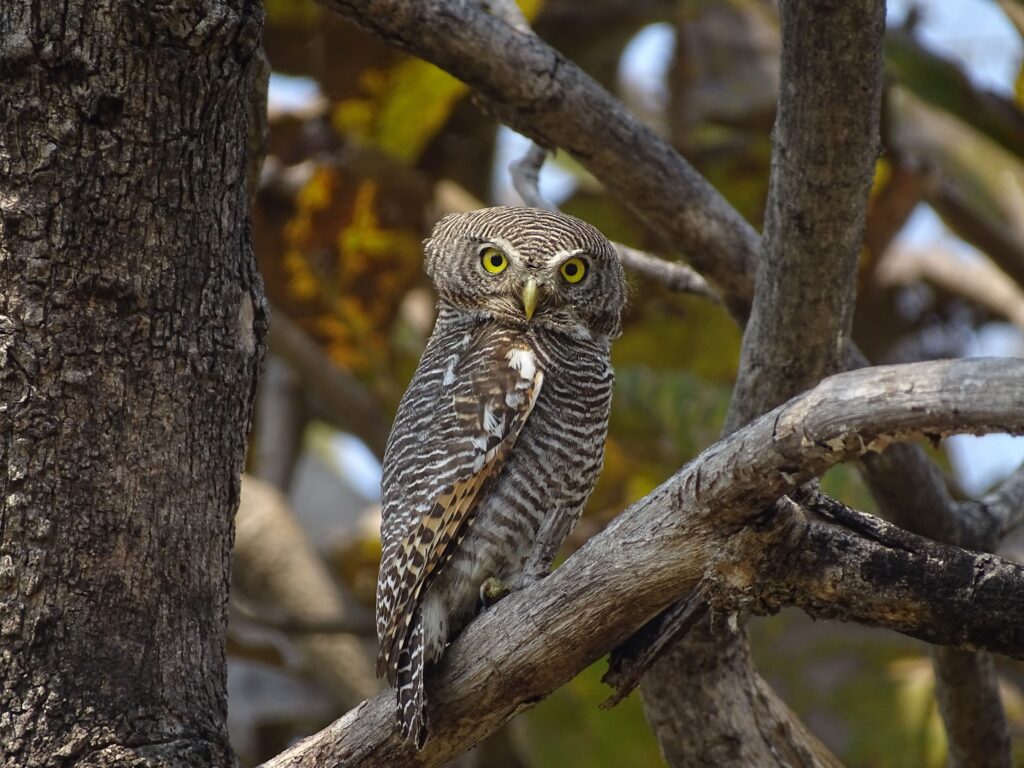
Jungle owlets are small in size, with a round head and small bars. They are also known as Barred Jungle Owlet. They can be found in India, Sri Lanka, Nepal, Bhutan, Myanmar, and Bangladesh.
Description: The facial disc is indistinct, while the chin, short eyebrows and moustachial streak are pure white. Eyes are bright lemon-yellow. The bill is greenish-yellow to yellowish-grey. There is a white patch on the breast. Upper parts are dark greyish-brown, and densely marked with narrow, pale ochre or rufous bars. There are bars on the back, rump and upper tail-coverts are often pure white.
The underparts are white, more or less tinged rufous.
Size: They are about 20 cms weighing approximately between 88-114 gms.
Habits: The Barred Jungle Owlet is a generally crepuscular owl most active an hour or so before dusk and dawn, and also moves about during the night. Frequents the tops of tall trees, usually on steep hillsides. These owls can be seen sunbathing in the early morning or late afternoon, and may fly freely and hunt in the daytime, especially if the weather is cloudy. But they usually roost during the day on a leafy branches, or in a tree hollow.
Calls and Hunting: The male terrotorial vocalization is a loud, musical, wooden trill. It starts softly, becomes louder and the fades away – praorr-praorr-praorr-praorr. A sequence of trilled notes – kwurr kwurr kwurr is also heard.
The Jungle owlet feeds on a variety of these invertebrates including grasshoppers, and cicadas. But its diet doesn’t stop there. It also feeds on reptiles, such as lizards, small birds, and small mammals, such as rodents and even molluscs.
Habitat: The habitat preferred by Jungle Owlets is deciduous jungles, foothills, scrub lands and bamboo plantations, and they can also be found near agricultural fields. They can be found in an elevation of upto 2000 m.
Nesting and Breeding: Breeding season for Jungle Owlets ranges from March to May. Nests are in natural tree hollows, or abandoned woodpecker or barbet holes; either in the trunk or branches of a tree standing in an open forest. Similar to many species of owls that depend on abandoned nests to lay their brood. The clutch includes 3-4 eggs.
IUCN Status: Least Concern
Best Seen: Satpura, Kanha, Pench, Panna, Tadoba
Spotted Owlet (Athene brama)
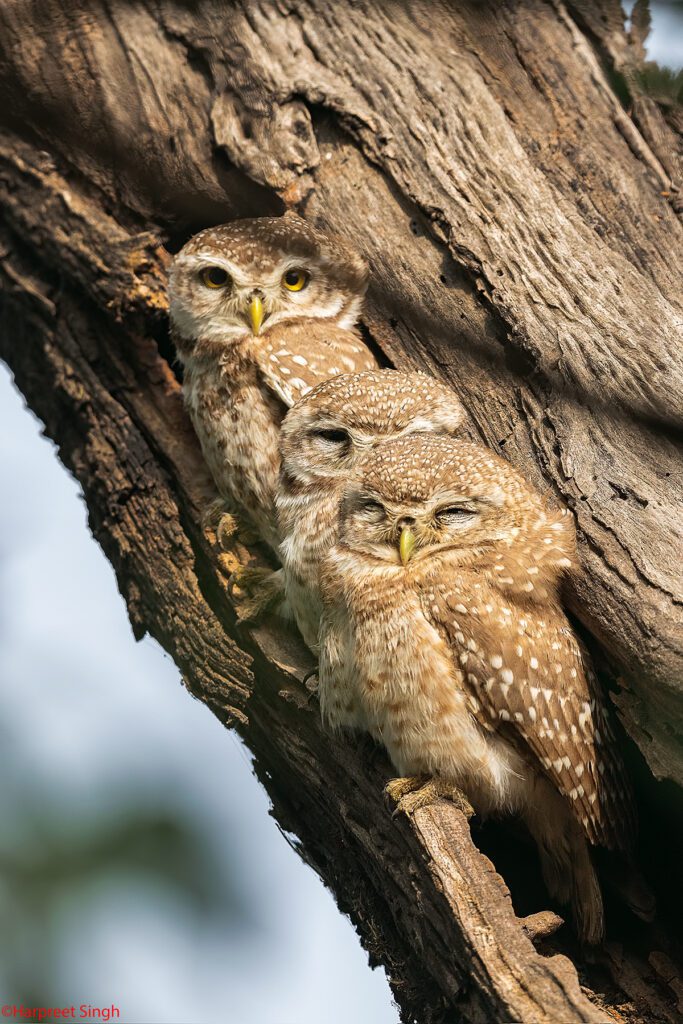
Also known as Spotted Little Owlet, this owlet is found distributed in Southern Asia, from Iran to Vietnam and the Indian subcontinent (except Sri Lanka) and Southeast Asia, except peninsular Thailand and Malaysia.
Description: The facial disc is creamy-buff with brown concentric lines. The forehead and lores are white to pale buffy. Eyebrows are white and curved. Eyes are pale to deep golden-yellow. The bill is greenish-horn, but sometimes darker, and sometimes more yellow. The wings are spotted and banded white, and the tail has narrow white bars.
Size: It is about 19-21 cms weighing 110-114 gms, and the females being a bit larger.
Habits: Generally crepuscular and nocturnal, but sometimes seen by day. Roosts by the day in tree holes, or on branches in pairs or small groups. Flight is deeply undulating, consisting of a few rapid flaps, followed by a glide with wings pressed to the body.
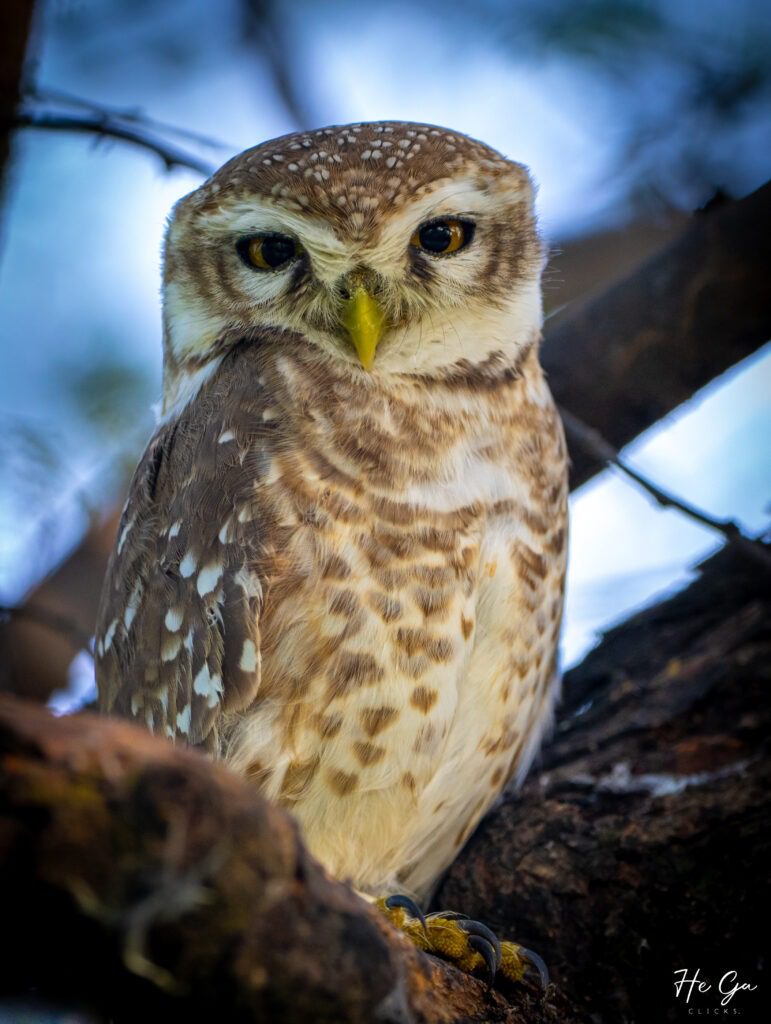
Calls and Hunting: Spotted Owlets have a harsh screeching vocalization – “chirurrr-chirurrr-chirurrr” followed by, or alternating with a call that sounds like – cheevak, cheevak, cheevak and a variety of other screeches and chuckles.
Mainly preys upon beetles, moths and other insects and earthworms, lizards, mice and small birds. Usually hunts from a perch, pouncing on prey, but occasionally catches insects while on flight. Often uses street lamps as hunting grounds, preying on insects attracted to the light.
Habitat: It prefers semi-desert, within and on the outskirts of villages and cultivation, groves with old trees, and ruins. The Spotted Owlets tend to avoid thick forests.
Nesting and Breeding: The nesting and breeding season starts in November and goes up until April. Nests are in natural tree hollows, or holes and cavities found in human dwellings. Spotted Owlets also tend to nest in cavities in the sides of ravines, and earth cliffs when suitable trees are scarce.
The nest is lined with grass and feathers.They don’t lay all the eggs at one time, hence the incubation often starts with one egg and ranges to 5 eggs, and the chick’s often look different in sizes.
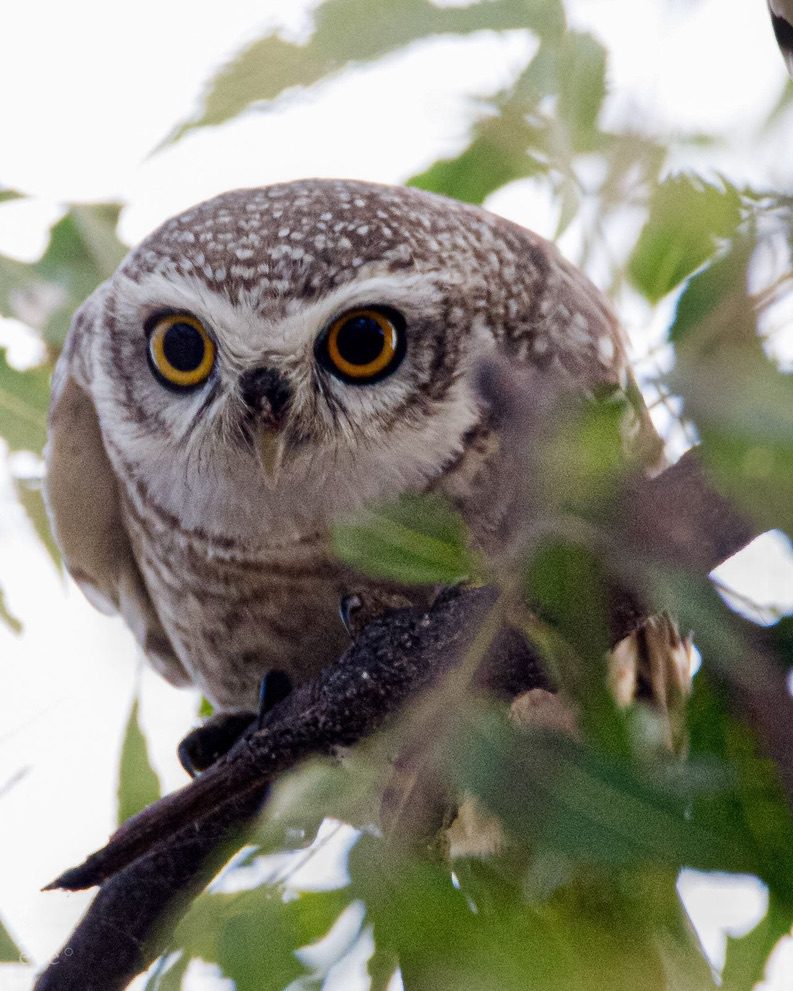
IUCN Status: Least Concern
Best Seen: All the forests of Central India have a good distribution of this species.
Forest Owlet (Athene blewitti)
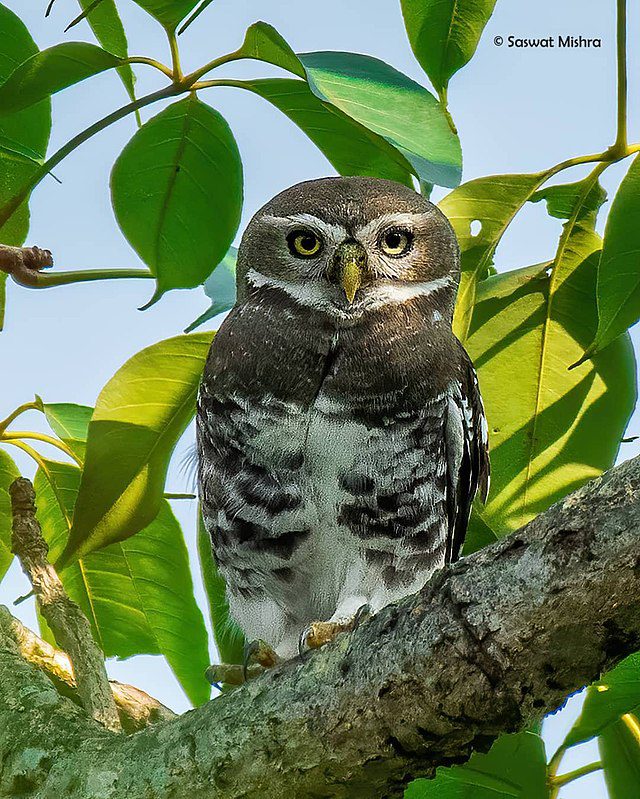
The Forest Owlet is a small owl, endemic to Central India this is an endangered owl species. While other owl species are distributed throughout the country, the Forest owlet has been reported only from locations in the Western Ghats and Satpura Hills.
Habitat fragmentation caused by the continued loss of deciduous forest, through illegal logging and expanding agriculture, has resulted in the continuous decline of this species belonging to the family Strigidae. The protected Melghat Tiger Reserve in Maharashtra is the species’ stronghold.
Description: The forest owlet has a facial disc that is pale and the eyes are yellow. It is a typical owlet with a rather unspotted crown and heavily banded wings and tail. They have a relatively large skull and beak. They can be distinguished from the Spotted owlet as it has the fewer and fainter spots on the crown and back. The upper parts are dark grey-brown. The wings and tail are banded with white trailing edges.
Size: It is small and about 23 cms and has a stocky structure. They weigh about 250 gms.
Habits: Extremely localized small owl, restricted to parts of West- Central India. Known locations are in lowland forest between 200 and 600 meters of elevation; and they appear to favour teak forests. Unlike other owls, Forest owlets are diurnal and hunt during the day and crepuscular (active at dusk and dawn).
Calls and Hunting: The calls are a steady “huhuhuhuhuhu” as well as different yapping and screeching calls. They mainly feed on small prey animals that live in under storey vegetation within the owlet’s habitat, such as lizards and and amphibians, small birds/nestlings, rodents and large invertebrates like grasshoppers. They are known to hunt preys twice their size too. These owlets had been observed to hide their prey in the hollow of tree trunks. They hunt from perches.
Habitat: It is thought that this owlet prefers subtropical and tropical dry deciduous forest, but has also been seen in moist deciduous forest or dense jungle and open dry deciduous teak woods.
Nesting and Breeding: The breeding season is usually from October and May in most of their range. The nesting sites of these species are hollows, in softwood trees.
The clutch usually contains two eggs. The male hunts and feeds the incubating female. The nestlings are fed by the parents. The chicks fledge after 30–32 days and are dependent on the parents for further 40-45 days.
They live for about 5.4 years.
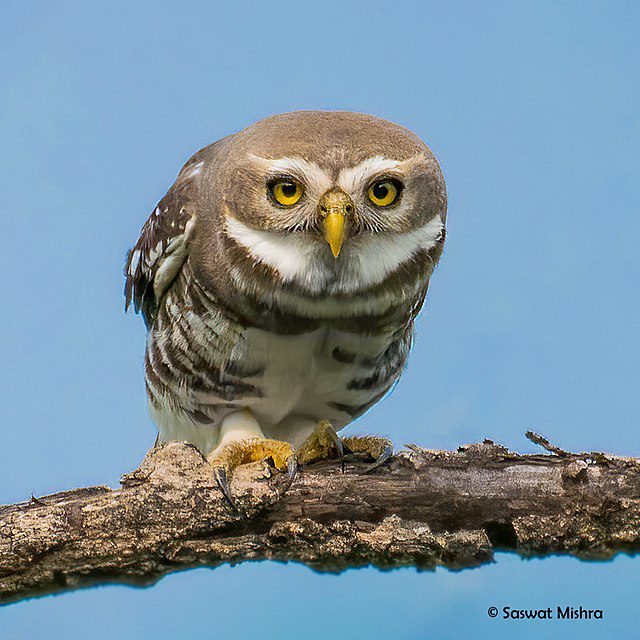
IUCN Status: Endangered. Endemic to the forests of Central India, loss and destruction of forest land, for conversion for agriculture and developmental activities; are some of the major threats to the species. According to the IUCN, there are only less than 1000 mature extant individuals of Forest Owlets.
Best Seen: It is distributed in the states of Gujarat (Purna Wildlife Sanctuary), Maharashtra (Melghat Tiger Reserve, Tansa Wildlife Sanctuary, Satpura Mountains, Toranmal Forest Range) and Madhya Pradesh (Khaknar and Piplod Forests and East and West Kalibhit Forests).
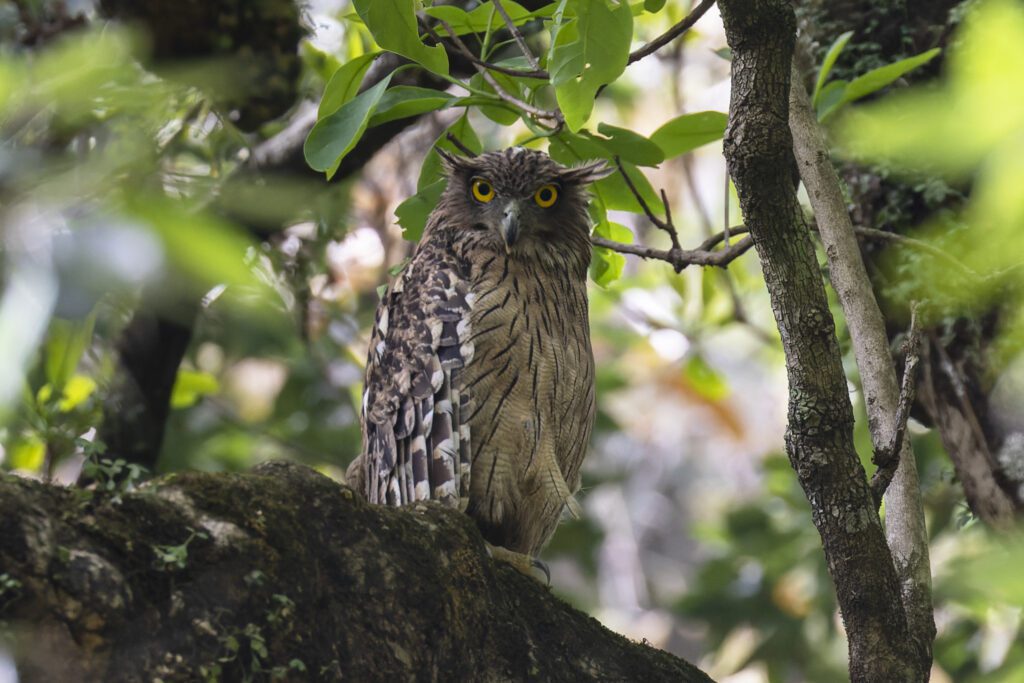
To catch a glimpse of these varied, fascinating species of owls in-person, do get in touch with our trip curators at Pugdundee Safaris.
We will help you book into our eco-luxury lodges and plan your be-spoke safaris experiences at Kanha, Pench, Bandhavgarh, Satpura, Panna and Tadoba.
Call us at: +91-9718637711, +91-8800637711
Email: [email protected]
We promise to take you on a one-of-its-kind wilderness holiday, you will treasure forever.
Written by: Natasha Sinha with valuable inputs from Shaikh Shaheen, Naturalist, Waghoba Eco-Lodge, Tadoba
References:
- Common Owls of India and Nepal – A research paper by Bikash Ghimre
- E-Bird India
- Merlin – All about Birds
- roundglasssustain.com
- Thank you: Bhavneet, Times School of Media and Abhishek Gulshan, Naturalist and Founder of Ninox – Owl about Nature; for assisting whole-heartedly with data and information. And all the people from the Bird Watching and Wildlife community who whole-heartedly contributed their personal photos.

